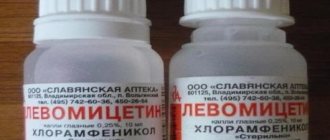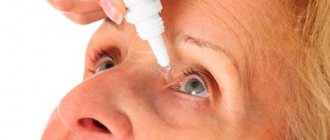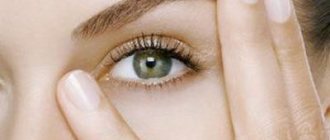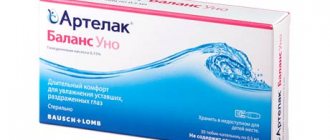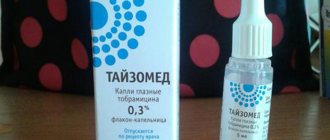When can you use pain relief drops yourself?
In optometry and ophthalmic surgery, eye drops are prescribed in different cases. They cannot be called universal, since in one case one remedy will help, in another - another.
However, general indications for use are:
- preparatory procedures for operations;
- removal of a foreign body;
- treatment of injuries;
- to relieve discomfort after vision correction using an excimer laser;
- for the treatment of pathological conditions of the visual system (blepharitis, uveitis, inflammation of the mucous membrane).
All medications are prescribed only by a doctor. In acute cases, when the pain is severe, you are allowed to use the medicine yourself, but strictly following the instructions and observing the dosage.
Increasing the dose will not improve the result, but sometimes causes side effects.
Anesthetic eye drops
Such anesthetic eye drops can block the perception of pain impulses for a short period of time. Similar drugs include Lidocoin, Inocaine, Alcaine, and so on.
After the drug hits the mucous membrane of the eye, pain relief begins. The effect of using such drugs does not last long: from 15 to 20 minutes. You should use such tools:
- For performing superficial anesthesia in eye surgery.
- Before removing a foreign body from the surface of the eyeball.
- For eye injuries.
- To carry out some diagnostic procedures: contact tonometry, gonioscopy, Schirmer test, and so on.
Features of application
Eye drops are instilled according to specific instructions. For pain relief, you must adhere to the rules of use.
Features of using eye drops:
- Before manipulation, wash your hands thoroughly with antibacterial soap, paying attention to the area under the nails and between the fingers, where a lot of dirt and dust accumulate.
- Before use, hold the container with the solution between your palms for 2–3 minutes. You should not use cold liquid, as unpleasant symptoms will appear.
- Clean your eyes from decorative cosmetics and remove contact vision correction products.
- Instill into the lower conjunctival sac. Then pinch the inner corner of the eye to prevent the medicine from leaking out and getting into the nasolacrimal duct.
- Massage a little to enhance the effectiveness of the effect and minimize systemic adverse reactions.
- Apply the second preparation only after 15 minutes. If it is an ointment, it is used after the drops. The fatty base prevents the penetration of the treatment solution.
If it is necessary to quickly relieve pain, for example, when scale gets into the eyes, local anesthetics are used. Non-steroidal medications do not provide quick results; their effect begins after a while, but the effect lasts longer.
Anti-inflammatory non-steroidal drops
Pain-relieving and anti-inflammatory eye drops in one bottle are prescribed more often than just anesthetics. Similar drugs include “Diklo F”, “Naklof”, “Indocollir” and so on. The mechanism of their action differs significantly from local anesthetics. Anti-inflammatory anesthetic eye drops reduce the synthesis of substances that cause inflammation. The effect becomes noticeable almost immediately. The drops contain non-steroidal components. They are usually prescribed:
- To eliminate pain after laser surgery.
- For anesthesia after abdominal eye surgery.
- For diseases caused by inflammation of the eyeballs: scleritis, iridocyclitis.
Contraindications
Anesthetic eye drops are contraindicated to use unless the cause of the pain is determined. They should not be taken without a doctor's prescription, since long-term use leads to irreversible damage to the cornea. In particular, to its clouding.
The use of painkillers is contraindicated if you are intolerant of the active or auxiliary component. Medicines are prohibited during pregnancy, breastfeeding and children under 12 years of age.
Non-steroidal medications are prohibited if blood clotting is impaired. Both types of painkillers are contraindicated in acute attacks of glaucoma.
When not to use anesthetics
Pain-relieving eye drops for local anesthesia should not be used until a specialist has determined the underlying cause of the discomfort. You should not use them without consulting a doctor. With their prolonged use, damage to the cornea occurs.
Uncontrolled use of anesthetic drops, as well as in the event of neurological pain, visual acuity may decrease, up to its complete loss. In addition, the cornea is severely damaged.
Using drops during pregnancy
Almost all eye drops are safe for use during pregnancy, since they are applied topically and practically do not enter the systemic circulation. In rare cases, when drops are used for a long time or incorrectly (after instillation the lacrimal sac area is not clamped), it is possible that they enter the nasal cavity, where the active substances can enter the bloodstream, thereby harming the fetus and the pregnant woman.
Since eye drops from the group of anesthetics are not used as a course, in fact, their use during pregnancy is completely safe, as practice shows. But according to the register of medicines, Dicaine and Lidocaine belong to group C for their effect on the fetus (no studies have been conducted on humans, but there are adverse effects in animals). Therefore, they should be used with caution and as prescribed by a doctor.
Clinical studies on animals have shown that all eye drops from the group of non-steroidal anti-inflammatory drugs are not recommended for use during pregnancy, especially in the 3rd semester. This is due to the fact that they negatively affect the development of the fetus. But clinical practice has not yet revealed any significant side effects from the fetus after using these drops in any semester of pregnancy.
"Indocollir" - eye drops
The instructions for use for this drug are quite simple. Such drops contain indomethacin, which is a substance that has an anti-inflammatory effect. The drug reduces the production of prostaglandins, which affect the development of the inflammatory process and sensitivity to pain.
Indocollir is used only topically. The drug is absorbed into the blood in minimal quantities and causes minor side effects. However, it should be noted that if abused, the concentration of the main component increases. The drug can also act when taken orally. The dosage and course of treatment should be prescribed by a specialist. Otherwise, serious complications may occur. You should strictly adhere to all instructions of specialists.
If you need to use several types of eye drops, it is recommended to take a short break between instillations. This will preserve the beneficial properties of the medicines for a long time.
What drops are suitable for eye pain
Eye drops with an anesthetic effect must be used according to a doctor's prescription.
This is dictated by the specific effects of these drops on vision. Uncontrolled use will lead to visual impairment and chronic pathologies. Anesthetics are rarely used as an independent treatment. This is part of complex therapy, which is designed to use antibacterial, antiviral, healing agents.
Pain is a consequence of a pathological condition and a common symptom, and not an independent problem. The cause may be an inflammatory process or injury.
Eye drops "Naklof"
This medicine contains diclofenac sodium. This substance perfectly relieves inflammation and pain. In addition, Naklof is an eye drop that reduces the production of prostaglandins in the area where the organ of vision is damaged. As a result, the drug has an analgesic effect.
Most often the drug is used in surgery. This is due to its unique properties. In addition, the drug does not affect the duration of wound healing. After instillation, Naklof does not penetrate the bloodstream. This avoids the development of some systemic side effects. The dosage, as well as the duration of therapy, must be agreed with the doctor.
How to use Alkain
The drug is easy to use. You need to add 2 drops and wait a little. After 30 seconds, the medicine will begin to act. The effect will last no more than 20 minutes. For tonometry, obtaining scrapings from the conjunctiva, one dose is sufficient. If you are undergoing cataract surgery. Then re-instillation is carried out after 10 minutes. If surgical intervention is required, which lasts more than half an hour, then a few more drops can be administered. After using Alcain, it is recommended to apply a bandage to the eye, as it will not react to environmental influences for some time and will lose sensitivity.
Who should not use it
"Indocollir" - eye drops, the instructions for use of which are described below, are not prescribed to patients with hypersensitivity to the substances included in the drug, as well as with intolerance to non-steroidal anti-inflammatory drugs and aspirin. It is undesirable to instill the drug for acute rhinitis, bronchial asthma, and urticaria.
Such eye drops should be used with caution by those who have problems with hematopoiesis, as well as herpetic keratitis.
When is it prescribed?
The properties of this drug allow it to be used for diagnostic and therapeutic purposes. Most often, Alcain drops are used for interventions that last a short period of time: cataract removal, removal of suture threads from the organ of vision, removal of a foreign body. The range of applications of such a drug is quite wide. The drug is instilled when measuring eye pressure, examining and measuring the anterior chamber of the organ of vision, when scraping from the conjunctiva, and so on.
Review of effective drugs
The list of pain-relieving eye drops includes many drugs. To choose an effective remedy, you need to consult an ophthalmologist.
Oxybuprocaine
The use of the substance helps eliminate the transmission of impulses to the tissues of the organ of vision. The drug is a local remedy that is widely used to relieve pain after surgery.
It is worth considering that after the introduction of the composition it is forbidden to drive a car, as this provokes a decrease in concentration.
Novocaine
This element is often used by welders because it successfully copes with glare in front of the eyes. Novocaine helps eliminate eye burns. However, the area of use of the substance is much more diverse. Novocaine is also used to provide other types of pain relief.
Octilia
The active ingredient of the substance is tetrizoline, which has vasoconstrictor properties. Thanks to this, it is possible to reduce the synthesis of ocular fluid and reduce its excretion. The preparation contains linden and chamomile extracts. This helps to obtain a pronounced anti-inflammatory effect.
When the substance is used, the visual organ is not so sensitive to the influence of external factors - allergens, mechanical damage and chemical elements. The desired result can be obtained literally 2-3 minutes after administration. The substance should be instilled into the conjunctival cavity. To do this, inject 1-2 drops of the product. The resulting effect lasts for 4-8 hours.
Lidocaine
This local anesthetic is actively used in ophthalmology. With its help, diagnostics and short manipulations are carried out on the eyes. The product is often used after operations.
The drug contains lidocaine in a volume of 2%. The product also includes additional substances - water, sodium chloride, etc. Doctors usually advise injecting 1-2 drops of the product into the conjunctival cavity. This is done 2-3 times a day. Do not use the composition if you are overly sensitive to its components.
Diclofenac
This product is packaged in sterile plastic containers and equipped with a dispenser attachment. Diclofenac is a non-steroidal anti-inflammatory substance. When applied locally, it is possible to achieve an anesthetic effect, cope with swelling and stop the inflammatory process.
After administration of the drug, the active substances enter the anterior part of the eye, but do not penetrate into the systemic bloodstream. Diclofenac is actively used to eliminate non-infectious diseases of the cornea or conjunctiva. It is also used to combat the consequences of traumatic eye injuries.
Alcaine
This is an analgesic drug that is produced in the form of a clear solution. The product is packaged in bottles with a dispenser. When active components get on the surface of the eye, they begin to be actively absorbed. This helps achieve local anesthetic effect.
The effect of using the substance occurs within half a minute and lasts for 20 minutes. If longer-term pain relief is needed, the drops are administered again.
A special feature of the product is its local effect. This means that the drug does not produce negative effects. The active substance of the drug is proxymethocaine. The drops do not cause side effects even if the dose is exceeded.
The medicine provokes blocking of pain that is transmitted along nerve fibers. The effect is associated with impaired absorption of sodium chloride. Alcaine is commonly used for therapy and diagnosis.
Drops are often administered during short operations, such as removing cataracts or removing sutures from the eyes. The product is also used to assess intraocular pressure and take a smear from the conjunctiva.
Indocollier
The main component of the substance is indomethacin. It helps stop inflammation. The drug provokes a decrease in the synthesis of prostaglandins, which cause inflammation. The medicine is suitable for topical use.
The main components of the drug penetrate into the systemic circulation in small quantities. Therefore, the product practically does not cause unwanted effects. However, it is not recommended to use the product for too long, as there is a risk of increasing the volume of the active substance.
The volume and duration of treatment is determined by the doctor. With self-therapy, there is a possibility of negative consequences. They manifest themselves in the form of an inflammatory process, lacrimation, and a burning sensation. When combining Indocollir with other drops, the interval between administrations should be at least a quarter of an hour.
Naklof
The active substance of the drug is diclofenac sodium. The product produces an analgesic effect and helps relieve inflammation. The activity of the substance is aimed at reducing the synthesis of prostaglandins in the affected area. This causes a decrease in pain. Naklof is actively used in surgery. The dosage and duration of treatment should be determined by the doctor.
What drops will aggravate the eye condition?
Drops used uncontrollably, or not suitable for individual indicators. Therefore, before use, you should consult an ophthalmologist.
The doctor will make an appointment immediately after the examination. The underlying causes will be identified and appropriate treatment will be prescribed.
Need to consider:
- Medicines taken.
- Accompanying illnesses.
- Age-related changes.
- Gender.
- Hereditary factors.
- Previous illnesses.

